Pass Your 3V0-42.20 Dumps as PDF Updated on 2023 With 59 Questions
VMware 3V0-42.20 Real Exam Questions and Answers FREE
NEW QUESTION # 10
Which type of design includes vendor models, host names, IP Addresses, port connections, logical unit number sizes, and number of CPUs? (Choose the best answer.)
- A. Logical Design
- B. High-Level Design
- C. Conceptual Design
- D. Physical Design
Answer: D
NEW QUESTION # 11
A Solutions Architect is assisting a service provider with designing an NSX-T Data Center solution for these environments:
Virtual Data Center to Virtual Data Center connectivity
Tenant workload on-boarding to Virtual Data Centers.
These requirements must be met:
scalability across 5 data centers
all sites have a latency of 180ms
MTU between sites is 1800
bandwidth is 100Mbps between sites
multi-tenancy
Which two selections should the Solutions Architect propose to the service provider? (Choose two.)
- A. Configure IPSec VPN for Tenant T0 gateways for Virtual Data Centers connectivity
- B. Configure Remote TEPs for stretching network services between Virtual Data Centers.
- C. Configure IPSec VPN for Tenant T1 gateways for Virtual Data Centers connectivity.
- D. Utilize L2 VPN for workloads on-boarding from on-premises to Virtual Data Centers.
- E. Utilize SSL VPN for workloads on-boarding from on-premises to Virtual Data Centers.
Answer: C,D
Explanation:
As mentioned, using Federation for five sites is not possible yet. Therefore, we have to setup L2VPN. IPSec (needed by L2VPN) can be established from T0 as well as T1 (the same rule applies to L2VPN). However, L2VPN is limited (server or client) to one service per gateway, therefore it's not possible to utilize five L2VPN tunnels from the same T0 and we have to deploy five T1s.
NEW QUESTION # 12
An architect is helping an organization with the Logical Design of an NSX-T Data Center solution.
This information was gathered during the Assessment Phase:
* Maximum performance and availability is required between the physical and virtual network.
* Load Balancing service is required for back-end web servers.
* NAT is required.
Which selection should the architect include in their design? (Choose the best answer.)
- A. Deploy an Active/Standby Tier-0 gateway and configure ECMP.
- B. Deploy an Active/Active Tier-0 gateway and configure ECMP.
- C. Deploy a Tier-1 gateway and connect it to an Active/Active Tier-0 gateway with ECMP configured.
- D. Create two separate VLANs to connect the Tier-0 gateway upstream traffic and configure ECMP.
Answer: A
Explanation:
Explanation/Reference:
NEW QUESTION # 13
An architect is designing a solution for containerization. The solution will include high availability and security using NSX-T Data Center. The architect plans to provide a basic required components list in the Logical Design.
Which solution should the architect recommend? (Choose the best answer.)
- A. 3 NSX Managers, 3 virtual NSX Edges, two Tier-0 gateways in Active/Standby, BGP configuration
- B. 2 NSX Managers, 2 virtual NSX Edges, one Tier-0 gateway, BGP configuration and a static route
- C. 1 NSX Manager, 2 virtual NSX Edges, two Tier-0 gateways in Active/Active, BGP configuration
- D. 3 NSX Managers, 3 virtual NSX Edges, one Tier-0 gateway and a static route and OSPF
Answer: A
NEW QUESTION # 14
According to the Discover Task of the Engagement Lifecycle, which statement would be classified as a risk? (Choose the best answer.)
- A. A merger and acquisition process was recently completed and new company on-boarding is not completed.
- B. To retain certification to provide financial services to end customers, PCI-DSS audits need to be passed.
- C. Enough power and cooling capacity is available in each rack in the data center.
- D. Due to existing contracts and purchase agreements, the existing server hardware needs to be reused.
Answer: B
NEW QUESTION # 15
An architect is helping an organization with the Logical Design of an NSX-T Data Center solution. This information was gathered during the Assessment Phase:
Customer is concerned with NSX Manager availability.
3 cabinets/racks are available in the data center.
No integration with 3rd party solution is required.
There is no budget for physical equipment acquisition.
The 3 cabinets/racks do not share the same L2 domain.
Which three selections should the architect include in their design to address the customer's concern with NSX Manager availability? (Choose three.)
- A. Use another NSX Manager IP in case an appliance fails.
- B. Use a physical/internal load-balancer with the cluster.
- C. Use separate IP per NSX Manager appliance per rack.
- D. Deploy a single active NSX Manager appliance in rack 1.
- E. Deploy 2 cold standby NSX Manager appliances in rack 2/3.
- F. Deploy an NSX Manager Appliance per rack and cluster them.
Answer: B,C,F
Explanation:
https://docs.vmware.com/en/VMware-NSX-T-Data-Center/2.4/installation/GUID-72A55651-0031-43A4-9F23-5950C1AFF304.html
https://vxplanet.com/2020/03/26/using-nsx-t-loadbalancer-for-the-nsx-t-management-cluster-part-1/
https://vxplanet.com/2020/03/26/using-nsx-t-loadbalancer-for-the-nsx-t-management-cluster-part-2/
NEW QUESTION # 16
An architect is helping an organization with the Physical Design of an NSX-T Data Center solution.
This information was gathered during a workshop:
Any proposed solution must provide low latency.
Any proposed solution must provide high throughput.
Customer is running stock trading applications.
Which two selections should the architect recommend to meet high-performance workload requirements? (Choose two.)
- A. Leverage ESXi as the compute host.
- B. Use LACP for all uplink profiles.
- C. Enable enhanced data path mode on the N-VDS.
- D. Enable latency sensitivity mode on the N-VDS.
- E. Leverage KVM as the compute host.
Answer: A,C
Explanation:
N-VDS and VDS support the following modes: Standard: Provide forwarding capabilities on both KVM and ESX transport nodes and does not require a specialized hardware. Enhanced Datapath: Available for ESXi transport nodes only and provide Enhanced Network Stack (ENS) targeted for Network Functions Virtualization (NFV) applications that require a faster performance data path.
NEW QUESTION # 17
Refer to the exhibits.
Design Option1: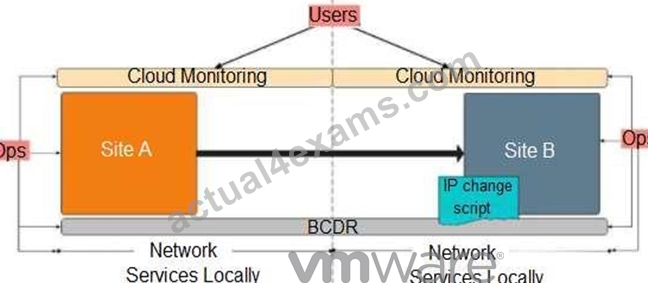
Design Option 2: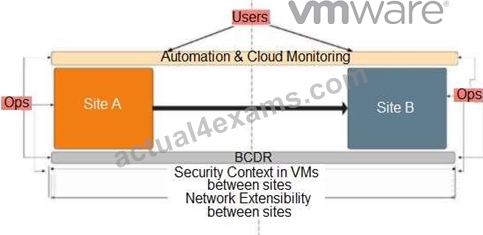
Design Option 3: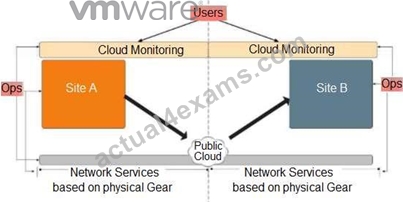
Design Option 4: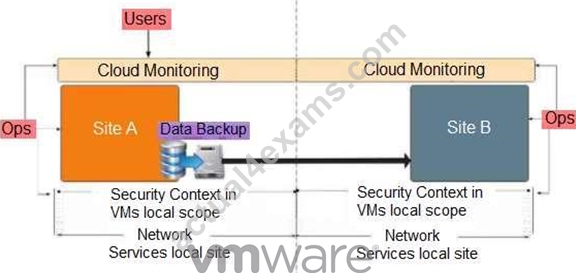
An architect is helping an organization with the Conceptual Design of an NSX-T Data Center solution.
The conceptual design includes these requirements, assumptions, constraints, and risks:
* Critical applications must run across sites without changing IP address.
* Business continuity and disaster recovery (BCDR) plans will leverage a second site running vSphere.
* RTO/RPO must be reduced for recovery of applications on secondary site.
* IT Teams require automation tools for configuration.
Which Conceptual Design would the architect recommend to the customer? (Choose the best answer.)
- A. Design Option 3
- B. Design Option 4
- C. Design Option 2
- D. Design Option 1
Answer: D
NEW QUESTION # 18
A Solution Architect will be deploying an Ethernet Virtual Private Network (EVPN) in their NSX-T Data Center environment.
What two selections must be prepared for the EVPN deployment? (Choose two.)
- A. deployed Tier-0 gateway
- B. deployed Tier-1 gateway
- C. remote gateway with support for IGP and VLAN priority
- D. remote gateway with support for MP-BGP and VXLAN
- E. deployed Load Balancer
Answer: D,E
NEW QUESTION # 19
Which three assessment findings are part of a Conceptual Design? (Choose three.)
- A. vendor model
- B. constraints
- C. assumptions
- D. risks
- E. justifications
- F. host names
Answer: B,D,E
NEW QUESTION # 20
Which two benefits can be achieved using in-band management of an NSX Bare Metal Edge Node?
(Choose two.)
- A. Reduces storage requirements.
- B. Preserves switchports.
- C. Reduces egress data.
- D. Reduces cost.
- E. Preserves packet locality.
Answer: C,D
NEW QUESTION # 21
An architect is helping an organization with the Physical Design of an NSX-T Data Center solution.
This information was gathered during a workshop:
Any proposed solution must provide low latency.
Any proposed solution must provide high throughput.
Customer is running stock trading applications.
Which two selections should the architect recommend to meet high-performance workload requirements? (Choose two.)
- A. Leverage ESXi as the compute host.
- B. Use LACP for all uplink profiles.
- C. Enable enhanced data path mode on the N-VDS.
- D. Enable latency sensitivity mode on the N-VDS.
- E. Leverage KVM as the compute host.
Answer: A,C
NEW QUESTION # 22
An architect is helping an organization with the Logical Design of an NSX-T Data Center solution.
This information was gathered during the Assessment Phase:
There is a performance based SLA for East - West traffic.
The business critical applications require prioritization of their traffic.
One of the services is a file share and has a high demand for bandwidth.
Which selection should the architect include in their design? (Choose the best answer.)
- A. Monitor East-West traffic throughout normal business cycles.
- B. Review average North/South traffic from the core switches and firewall.
- C. Meet with the organization's application team to get additional information.
- D. Include a segment QoS profile and review the impact of utilizing this feature.
Answer: D
NEW QUESTION # 23
An architect is helping an organization with the Logical Design of a Layer 2 bridging solution.
This information was gathered during the Assessment Phase:
Workloads are running on ESXi hosts.
Workloads are running on KVM hosts.
Workloads on hypervisors should use bridging services.
VLAN 50 is used for Tier-0 uplink connectivity.
Which selection should the architect include in their design? (Choose the best answer.)
- A. Create an ESXi Bridge Cluster and configure the bridging profile with VLAN 50.
- B. Create an NSX Edge Bridge Cluster and configure the bridging profile with VLAN 60.
- C. Create an ESXi Bridge Cluster and configure the bridging profile with VLAN 60.
- D. Create an NSX Edge Bridge Cluster and configure the bridging profile with VLAN 50.
Answer: D
NEW QUESTION # 24
An architect is helping an organization with the Physical Design of an NSX-T Data Center solution.
This information was gathered during a workshop:
There are six hosts and hardware has already been purchased.
Customer is planning a collapsed Management/Edge/Compute cluster.
Each host has two 10Gb NICs connected to a pair of switches.
There should be no single point of failure in any proposed design.
Which virtual switch design should the architect recommend to the organization? (Choose the best answer.)
- A. Create a vSphere Distributed Switch (vDS) for Management VMkernel traffic and assign one NIC. Also, create an NSX-T Virtual Distributed Switch (N-VDS) for overlay traffic and assign one NIC.
- B. Create an NSX-T Virtual Distributed Switch (N-VDS) for Management VMKernel and overlay traffic and assign both NICs.
- C. Create an NSX-T Virtual Distributed Switch (N-VDS) for Management VMkernel and overlay traffic and assign a new virtual NIC.
- D. Create an NSX-T Virtual Distributed Switch (N-VDS) for Management VMkernel traffic and assign one NIC. Also, create an NSX-T Virtual Distributed Switch (N-VDS) for overlay traffic and assign one NIC.
Answer: A
NEW QUESTION # 25
An architect is helping an organization with the Physical Design of an NSX-T Data Center solution.
This information was gathered during a workshop:
Current hypervisor of choice is KVM.
Cost reduction is important.
Which two selections should the architect recommend to the organization? (Choose two.)
- A. Deploy NSX Manager using QCOW2.
- B. Deploy Edge VM Nodes using ISO.
- C. Deploy bare metal Edge Nodes.
- D. Deploy Edge VM Nodes on KVM.
- E. Deploy NSX Manager using OVF.
Answer: A,C
NEW QUESTION # 26
Which three IPv6 features are supported in an NSX-T Data Center design? (Choose three.)
- A. IPv6 Distributed Firewall
- B. IPv6 VXLAN
- C. IPv6 static routing
- D. IPv6 OSPF
- E. IPv6 DNS
- F. IPv6 switch security
Answer: A,C,F
Explanation:
Explanation/Reference: https://blogs.vmware.com/networkvirtualization/2019/02/ipv6-support-in-nsx-t-2-4.html/
NEW QUESTION # 27
A Solutions Architect is working with a customer which wants to extend their traditional Telco IP/MPLS core network to an NFV cloud.
Which NSX-T Data Center feature can be recommended by the architect? (Choose the best answer.)
- A. EVPN
- B. Distributed IDS
- C. BGP
- D. Load Balancer
Answer: C
NEW QUESTION # 28
Which two VMware recommendations should an architect follow when configuring top of rack (ToR) switches in an NSX-T Data Center environment? (Choose two.)
- A. Configure switch ports that connect to ESXi host manually as trunk ports.
- B. Configure redundant physical switches to enhance availability.
- C. Use only IPv4 addressing in all deployments.
- D. Modify the Spanning Tree Protocol to increase the time to transition to the forwarding state.
- E. Configure switch ports with a Dynamic Trunking Protocol.
Answer: A,B
Explanation:
Top of Rack Physical Switches
When configuring top of rack (ToR) switches, consider the following best practices:
- Configure redundant physical switches to enhance availability.
- Configure switch ports that connect to ESXi hosts manually as trunk ports. Virtual switches are passive devices and do not support trunking protocols, such as Dynamic Trunking Protocol (DTP).
- Modify the Spanning Tree Protocol (STP) on any port that is connected to an ESXi NIC to reduce the time to transition ports over to the forwarding state, for example using the Trunk PortFast feature found in a Cisco physical switch.
- Provide DHCP or DHCP Helper capabilities on all VLANs used by TEP VMkernel ports. This setup simplifies the configuration by using DHCP to assign IP address based on the IP subnet in use.
- Configure jumbo frames on all switch ports, inter-switch link (ISL), and switched virtual interfaces (SVIs).
https://docs.vmware.com/en/VMware-Validated-Design/5.0.1/vmware-validated-design-501-sddc-nsxt-workload-architecture-design.pdf
NEW QUESTION # 29
Refer to the exhibit.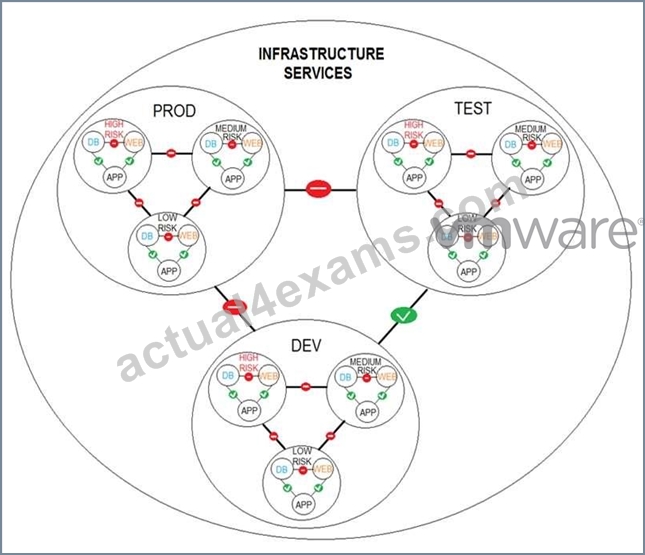
A financial company is adopting micro-services with the intent of simplifying network security. An NSX-T architect is proposing a NSX-T Data Center micro-segmentation logical design. The architect has created a diagram to share with the customer.
How many security levels will be implemented according to this Logical Design? (Choose the best answer.)
- A. 5 levels
- B. 4 levels
- C. 9 levels
- D. 3 levels
Answer: A
NEW QUESTION # 30
......
Pass VMware 3V0-42.20 Exam Info and Free Practice Test: https://www.actual4exams.com/3V0-42.20-valid-dump.html

